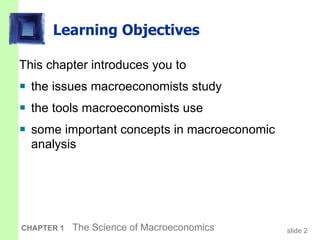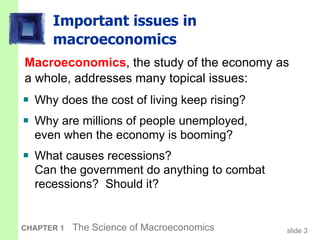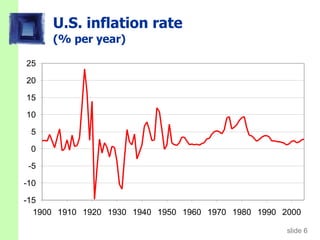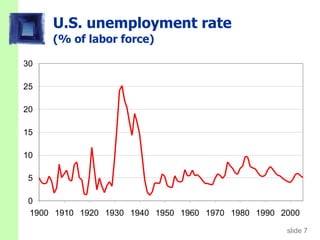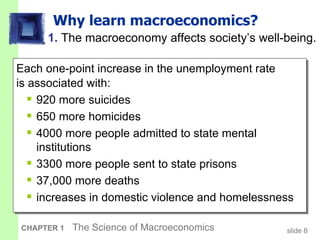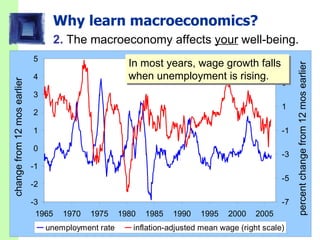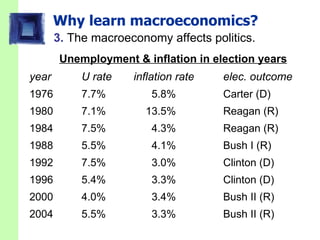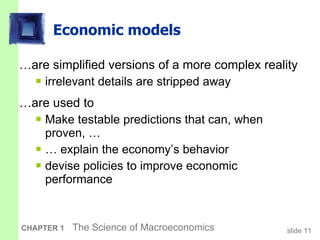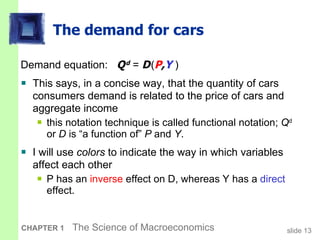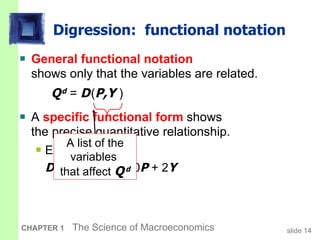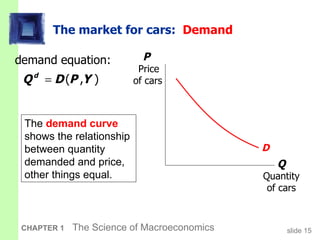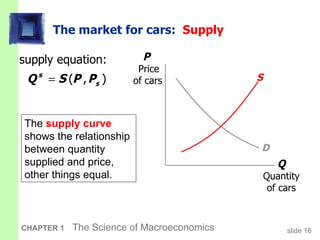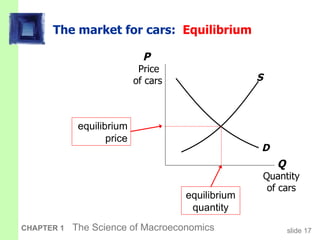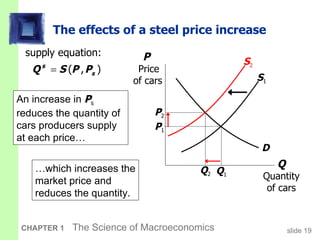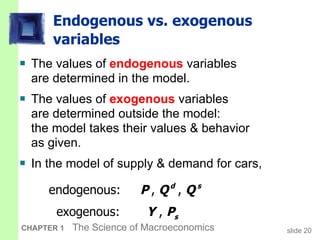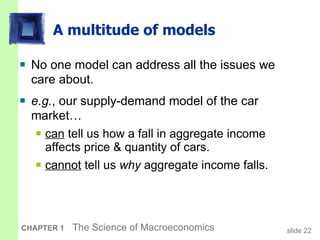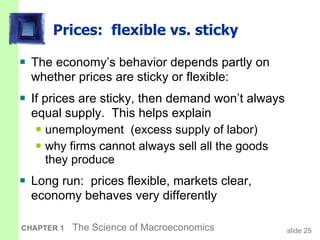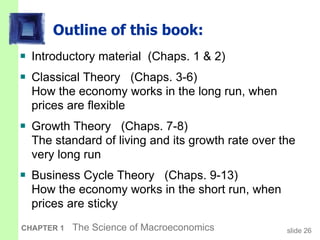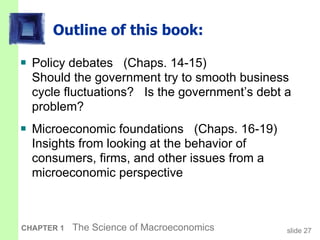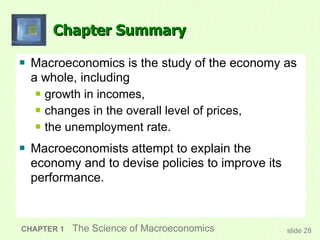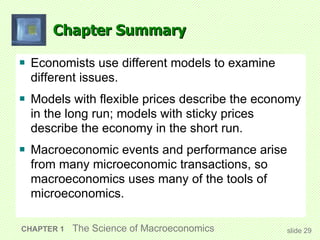Chap01
- 1. The Science of Macroeconomics 1
- 2. Learning Objectives This chapter introduces you to the issues macroeconomists study the tools macroeconomists use some important concepts in macroeconomic analysis
- 3. Important issues in macroeconomics Why does the cost of living keep rising? Why are millions of people unemployed, even when the economy is booming? What causes recessions? Can the government do anything to combat recessions? Should it? Macroeconomics , the study of the economy as a whole, addresses many topical issues:
- 4. Important issues in macroeconomics What is the government budget deficit? How does it affect the economy? Why does the U.S. have such a huge trade deficit? Why are so many countries poor? What policies might help them grow out of poverty? Macroeconomics , the study of the economy as a whole, addresses many topical issues:
- 5. U.S. Real GDP per capita (2000 dollars) long-run upward trendŌĆ” Great Depression World War II First oil price shock Second oil price shock 9/11/2001
- 6. U.S. inflation rate (% per year)
- 7. U.S. unemployment rate (% of labor force)
- 8. Why learn macroeconomics? 1. The macroeconomy affects societyŌĆÖs well-being. Each one-point increase in the unemployment rate is associated with: 920 more suicides 650 more homicides 4000 more people admitted to state mental institutions 3300 more people sent to state prisons 37,000 more deaths increases in domestic violence and homelessness
- 9. Why learn macroeconomics? 2. The macroeconomy affects your well-being. In most years, wage growth falls when unemployment is rising. change from 12 mos earlier percent change from 12 mos earlier
- 10. Why learn macroeconomics? 3. The macroeconomy affects politics. Unemployment & inflation in election years year U rate inflation rate elec. outcome 1976 7.7% 5.8% Carter (D) 1980 7.1% 13.5% Reagan (R) 1984 7.5% 4.3% Reagan (R) 1988 5.5% 4.1% Bush I (R) 1992 7.5% 3.0% Clinton (D) 1996 5.4% 3.3% Clinton (D) 2000 4.0% 3.4% Bush II (R) 2004 5.5% 3.3% Bush II (R)
- 11. Economic models ŌĆ”are simplified versions of a more complex reality irrelevant details are stripped away ŌĆ”are used to Make testable predictions that can, when proven, ŌĆ” ŌĆ” explain the economyŌĆÖs behavior devise policies to improve economic performance
- 12. Example of a model: Supply & demand for new cars shows how various events affect price and quantity of cars assumes the market is competitive : each buyer and seller is too small to affect the market price Variables: Q d = quantity of cars that buyers demand Q s = quantity that producers supply P = price of new cars Y = aggregate income P s = price of steel (an input)
- 13. The demand for cars Demand equation: Q d = D ( P , Y ) This says, in a concise way, that the quantity of cars consumers demand is related to the price of cars and aggregate income this notation technique is called functional notation; Q d or D is ŌĆ£a function ofŌĆØ P and Y . I will use colors to indicate the way in which variables affect each other P has an inverse effect on D, whereas Y has a direct effect.
- 14. Digression: functional notation General functional notation shows only that the variables are related. Q d = D ( P,Y ) A specific functional form shows the precise quantitative relationship. Example: D ( P,Y ) = 60 ŌĆō 10 P + 2 Y A list of the variables that affect Q d
- 15. The market for cars: Demand Q Quantity of cars P Price of cars The demand curve shows the relationship between quantity demanded and price, other things equal. D
- 16. The market for cars: Supply Q Quantity of cars P Price of cars D S The supply curve shows the relationship between quantity supplied and price, other things equal.
- 17. The market for cars: Equilibrium Q Quantity of cars P Price of cars S D equilibrium price equilibrium quantity
- 18. The effects of an increase in income An increase in income increases the quantity of cars consumers demand at each priceŌĆ” ŌĆ” which increases the equilibrium price and quantity. Q Quantity of cars P Price of cars S D 1 Q 1 P 1 P 2 Q 2 D 2
- 19. The effects of a steel price increase An increase in P s reduces the quantity of cars producers supply at each priceŌĆ” ŌĆ” which increases the market price and reduces the quantity. Q Quantity of cars P Price of cars S 1 D Q 1 P 1 P 2 Q 2 S 2
- 20. Endogenous vs. exogenous variables The values of endogenous variables are determined in the model. The values of exogenous variables are determined outside the model: the model takes their values & behavior as given. In the model of supply & demand for cars,
- 21. Now you try: Write down demand and supply equations for wireless phones; include two exogenous variables in each equation. Draw a supply-demand graph for wireless phones. Use your graph to show how a change in one of your exogenous variables affects the modelŌĆÖs endogenous variables.
- 22. A multitude of models No one model can address all the issues we care about. e.g. , our supply-demand model of the car marketŌĆ” can tell us how a fall in aggregate income affects price & quantity of cars. cannot tell us why aggregate income falls.
- 23. A multitude of models So we will learn different models for studying different issues ( e.g ., unemployment, inflation, long-run growth). For each new model, you should keep track of its assumptions which variables are endogenous, which are exogenous the questions it can help us understand, and those it cannot
- 24. Prices: flexible vs. sticky Market clearing : An assumption that prices are flexible, adjust to equate supply and demand. In the short run, many prices are sticky ŌĆō adjust sluggishly in response to changes in supply or demand. For example, many labor contracts fix the nominal wage for a year or longer many magazine publishers change prices only once every 3-4 years
- 25. Prices: flexible vs. sticky The economyŌĆÖs behavior depends partly on whether prices are sticky or flexible: If prices are sticky, then demand wonŌĆÖt always equal supply. This helps explain unemployment (excess supply of labor) why firms cannot always sell all the goods they produce Long run: prices flexible, markets clear, economy behaves very differently
- 26. Outline of this book: Introductory material (Chaps. 1 & 2) Classical Theory (Chaps. 3-6) How the economy works in the long run, when prices are flexible Growth Theory (Chaps. 7-8) The standard of living and its growth rate over the very long run Business Cycle Theory (Chaps. 9-13) How the economy works in the short run, when prices are sticky
- 27. Outline of this book: Policy debates (Chaps. 14-15) Should the government try to smooth business cycle fluctuations? Is the governmentŌĆÖs debt a problem? Microeconomic foundations (Chaps. 16-19) Insights from looking at the behavior of consumers, firms, and other issues from a microeconomic perspective
- 28. Chapter Summary Macroeconomics is the study of the economy as a whole, including growth in incomes, changes in the overall level of prices, the unemployment rate. Macroeconomists attempt to explain the economy and to devise policies to improve its performance. CHAPTER 1 The Science of Macroeconomics slide
- 29. Chapter Summary Economists use different models to examine different issues. Models with flexible prices describe the economy in the long run; models with sticky prices describe the economy in the short run. Macroeconomic events and performance arise from many microeconomic transactions, so macroeconomics uses many of the tools of microeconomics. CHAPTER 1 The Science of Macroeconomics slide
Editor's Notes
- #2: Dear Colleague, Thank you for trying these PowerPoints. I have worked hard to make them useful, accurate, and interesting in hopes of saving you prep time and contributing to an effective classroom experience for your students. To help you get the most from these slides, I have prepared a README file with User Instructions, and I have annotated many individual slides with notes ŌĆō visible only to you ŌĆō that appear in this area of your screen. I will be preparing minor updates about once a year between major revisions of the text, to update the data and correct typos, etc. If you find a typo or have a suggestion, please email it to me and I will consider it for the next update. My email address is roncron@unlv.nevada.edu. Sincerely, Ron Cronovich
- #4: This slide and the next contain a list of some topical issues that macro can help students understand. Feel free to substitute others as new issues emerge.
- #9: It might be useful to briefly define the unemployment rate so that students will be able to understand this and the next few slides. Source: Barry Bluestone and Bennett Harrison, The Deindustrialization of America (New York: Basic Books, 1982), Chapter 3, cited in Robert J. Gordon, Macroeconomics, 4 th edition (Boston: Little, Brown and Company), p.334. If you know of more recent estimates, please email me so I can update this slide!!! Thanks! (My email address is roncron@unlv.nevada.edu)
- #10: Macroeconomics helps students understand forces that will affect their financial well-being. HereŌĆÖs an example. When the unemployment rate is rising, tens or hundreds of thousands of people are losing their jobs. This affects even those who donŌĆÖt lose their jobs: As the graph shows, during most years there is a clear negative relationship between the (12-month) change in unemployment and the annual growth rate of real wages. In plain English, rising unemployment is associated with falling (and often negative) wage growth. So when the economy goes into recession, even if our students get to keep their jobs, they will find it much harder to get a raise, and may have to accept a real wage cut. Students find this relationship intuitive. When unemployment is rising, the supply of workers is rising faster than demand, so wages grow more slowly or even fall. Conversely, falling unemployment gives workers more bargaining power over wages, as it becomes increasingly hard for employers to replace their workers, and increasingly easy for workers to find good opportunities with other companies.
- #11: IŌĆÖd also suggest you briefly define the inflation rate (as the percentage increase in the cost of living) to help students understand this slide. Main point of this data: The state of the economy has a huge impact on election outcomes. When the economy is doing poorly, there tends to be a change in the party that controls the White House. 1976: The rates of inflation ( ’ü░ ) and unemployment ( u ) both high. Incumbent (Ford, R) loses. 1980: u still high, ’ü░ even higher. Incumbent (Carter, D) loses. 1984: u still high, but ’ü░ much lower. Incumbent (Reagan) wins. 1988: ’ü░ the same, u much lower. Incumbent party wins. 1992: ’ü░ low, but u much higher (and was higher yet in 1991). Incumbent loses. 1996: u much lower, incumbent wins. 2000: Economy doing great, and incumbent party candidate (Gore, D) wins majority of popular vote, but loses electoral college to challenger. 2004: u somewhat higher, but lower than in 2001 recession; ’ü░ low; incumbent wins
- #13: Students will realize that the auto market is not competitive. However, if all we want to know is how an increase in the price of steel or a fall in consumer income affects the price and quantity of autos, then itŌĆÖs fine to use this model. In general, making unrealistic assumptions is okay, even desirable, if they simplify the analysis without affecting its validity.
- #15: We often arenŌĆÖt concerned with the exact quantitative relationship between variables, so we will often just use the general functional notation.
- #22: Endogenous variables: price of wireless phones, quantity of wireless phones Exogenous variables: consumer income price of wireless phone service (a complement) price of landline phones & phone service (a substitute) technology
- #27: The portion of the book described on this slide comprises the core material. It is organized around time horizons: the long run (flexible prices), the very long run (growth in capital, the population, and technology itself), and the short run (sticky prices and economic fluctuations). But wait! ThereŌĆÖs more! See the next slideŌĆ”.
- #28: All of the chapters listed on this slide are very good, but some instructors find that the semester isnŌĆÖt always long enough to cover all of this material. Feel free to select chapters from these parts that best match the needs and interests of you and your students. *** Are you covering Chapter 2 next? The PowerPoint presentation for Chapter 2 includes some in-class exercises to immediately reinforce concepts as they are presented. These exercises also help break up the lecture into smaller pieces. If youŌĆÖd like to try them, please ask your students to bring calculators to the next class meeting.


